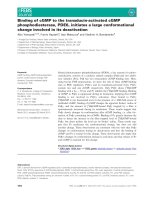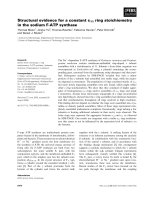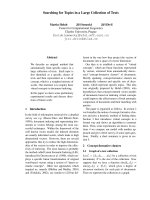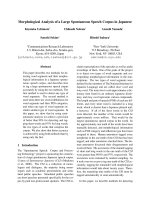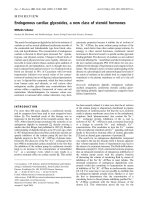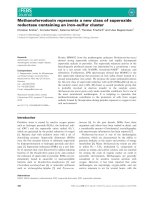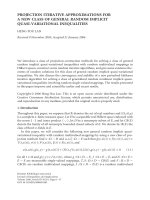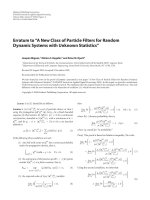FORTRAN: A LANGUAGE FOR EXPRESSING A LARGE CLASS OF PROBLEMS IN THE LANGUAGE OF MATHEMATICS
Bạn đang xem bản rút gọn của tài liệu. Xem và tải ngay bản đầy đủ của tài liệu tại đây (1.74 MB, 29 trang )
PR.ELIMINARY ROEPOR8T
Programming Research Group
Applied Science Division
International Business Machines Corporation
November 10, 1954
Specifications for System,
The IBM Mathematical FOR.mula
-F,ORTBA N
Copyright, 1954, by International Business Machines Go~ltpsxati~n
590 Madison Avenue, New York, 22, New York \---+.-._
- ---- --- -
PREiIM1NAR.Y RE P0R.T
Specifications for the IBM Mathematical F-0R.mula TR,ANslating System,
The iBM Mathematical Formula Translating System or briefly, FORITRAN, will
comprise a large s e t of programs to enable the IBM 704 to accept a concise
formulation of a problem in terms of a mathematical notation and to produce
aummatically a high speed 704 program for the solution of the problem. The
logic af the 704 is such that, for the f i r s t time, programming techniques have
bebr, devised which can be applied by an automatic coding system in such a way
that an automatically coded problem, which has been concisely stated in a
language which does not resemble a machine language, will be executed in
about the same time that would be required had the problem been laboriously
'nand coded. Heretofore, systems which have sought to reduce the job of
coding and debugging problems have offered the choice of easy coding and slow
execation or laborious coding and fast execution.
It is felt that FORXRAN offers a s convenient a language for stating prohlems
f o r machine solution a s is now known. Studies have indicated that a hand coded
program for a problem will usually contain at least 5 times a s many characters
and sometimes 20 times a s many characters a s the problem statement in
YORTRAN language. Furthermore, after an hour course in FOR.TRAN
ratation, the average programmer can fully understand the steps of a
procedure state3 in FOR ?RAN language without any additional comments.
Before considering the way in which a problem may be presented for automatic
coding by the FOR.TRAN system, it might be well to consider some of the
hdvantages of such a system. Basically, of course, the reason for the
existence of high speed computers is the fact that they make possible the
solution of problems in a much shorter time and at much l e s s cost than
would otherwise be required. The time and cost required for the solution
of a problem on a high speed calculator fall roughly into 4 catagories:
1. Analysis and Programming
2. Coding
3. Debugging
4. Machine Solution
1b. aster and more capacious machines will considerably reduce the cost and
time required for item 4 but s o f a r the advent of new machines seems to
have dorLelittle to reduce either the cost or time required for items 1,2,
and 3. It seems to be quite generally true that the personnel costs of a
computing installation a r e at least a s great as the machine cost. Further-
more, it is reasonable to assume that personnel cost for coding and debugging
-onStitute considerably more than half the total personnel cost. Finally, at
installations which have relatively few long term problems, a s much a s 1/2
of the machine cost is devoted. to d e bugging. Therefore, in a crude fashion
ane can say that out of every dollar spent to solve an average problem on a
high speed computer, l e s s than 25 cents is spent for analysis and programmin:',
more than 25 cents is spent for personnel coding and debugging cost, about
25 cents f o r machine debuggirg cost, and about 25 cents f o r machine running
cast.
S.me F ORTRAN should virtually eliminate coding and debugging, it should
oe possible to ~ l v peroblems for l e s s than half the cost that would be r e -
quired without such a system. Furthermore, since it will be possible to
%vote nearly all usable machine time to problem solution instead of only half
-tne usable machine time, the output of a given machine should be almost
doubled. Also, of course, the to:.al elapsed time for the solution of a problem
should be a small fraction of the time required without FOR#TRANsince the
time required for coding and debugging is usually more than 3/4 the total
elapsed time. Not only does FORTR.AN greatly reduce the initial investment
ir, sroducing a program, but it will reduce even more the cost of repro-
g-amming problems for future IBM calculators, since each such calculator
s h u l d have a system similar to FOR.TRAN accompanying it which could
:ranslate the statement of the-problem in a language very much like FOR.TRAN
LC its own code.
In addition to FDRTR AN'S great potentialities for economy, such a system
will make experimental investigation of various mathematical models and
numerical methods more feasible and convenient both in human and economic
terms. Also, FORTRAN may apply complex, lengthy techniques in coding
a problem which the human coder would have neither the time nor inclination
to derive or apply. Thus, in many cases, FORTRAN may actually produce
a better program than the normal human coder would be apt to produce.
Finally, the amount of knowledge necessary to utilize the 704 effectively
by means of F31irl'HAN is far less than the knowledge required to make
effective use of the 704 by direct coding. Information concerning how to
use subp~.ograms,what machine instructions a r e available, how to
optimize a sequence of calculations, and concerning a large number of other
coiling techniques, is built into the FOR.TRAN system and it is not necessary
f o r the programmer to be familiar with this information. In fact, a great
desl of the information the programmer needs to know about the FORTR.AN
sysrem is already embodied in his knowledge of mathe.aatics. Thus i t will
be possible to make the full capabilities of the 704 available to a much wider
range of ~ e o p l ethan would otherwise be possible without expensive and time
consuming training programs.
In summary, then, a system such a s FORTRAN has the following potential;
ities :
1. Great economy of time and money.
2. Feasibility of more mathematical experiments.
3. Ability to apply complex, lengthy techniques in coding a
problem.
4. Ability to make the 704 avilable to more people with more
convenience and less training.
Before beginning a description of the FORTR.AN system, it should be noted
L : -~ + the following description is intended only to indicate present plans. A l -
:bough the methods by which FOR.TR.AN will operate a r e well understood,
future developments in programming FOR*TR.ANmay necessitate certain minor
changes in the system a s it is presented below.
The following is a description of the admissible symbols and combinations of
symbols in the FORTRAN language and how to use it:
1. CONSTANTS
A . F E E D POINT (INTEGERS)
, i) .Gener-al Form:
1 to 5 sequential decimal digits optionally preceded by a plus or
minus sign
ii) E- xamp-le-s:
3. FLOATING POINT
i) General Form:
Any sequence of decimal digits with a decimal point preceding o r
intervening between any 2 digits o r following a sequence cd digits,
all of this optionally preceded by a plus o r minus sign.
The number must be l e s s than 103.8 in absolute value and
greater than in absolute value.
No specific list of functions is given since there is no limit on the number
crf possible functions. Functions must be single-valued.
A. GENERAL FORM:
Three or more alphabetic or numeric characters (beginning with an
alphabetic character) followed by a left parenthesis followed by 1st
argument followed by a right parenthesis o r by a comma followed
by 2nd argument followed by a right parenthesis or by a comma
followed by 3rd argument, etc.
EXAMPLES:
ii) s q r t(a+b) : means
iii) factl(m+n) : means (m+n) !
c.- -.
iv) sqrt(sin(axx2)) : m,eans4sinta2)
v) max(a, b, c, d, e) : means select the largest of the quantities
a, b, c,d, e.
Any sequence of variables and functions separated by operation
symbols and paretltheses which forms a meaningful mathematical
expression in the normal way. Note that every adjacent pair of
variables o r functions must be separated by an operation symbol.
By repeated use of the following rules, all legal expressions may
be derived and all expressions s o derived a r e legal provided they
have l e s s than 750 characters.
i) Any constant o r variable is an expression.
ii) If E is an expression not of the form +F o r -F',then +E and -E
are expressio~~s.
. iii) If xxx denotes a function of n arguments, and if E E2...En a r e
expressions, then in general xxx (E E2#.. ,Ed is an ex-
pression. Although functions may have this general fom*,certain
functions will place restrictions on the form of p e r m & s i b l ~
arguments. ,.
5
. 9
iv) If E is an expression, s o is (E)
v) If E and F a r e expressions where F is not of the form +G o r -G
and o is one of the permissible binary operations, then EoF is
an expression.
vi) If E and F a r e expressions, so is ExxF
C. EXAMPLES:
a/b/c Note that this is equivalent to (a/b)/c
a/bxc Note that this is equivalent to (a/b)xc
a/(b+c)xd Note that this is equivalent to (a/(btc))xd
a+sin(bxc / (d+(e+(f+g)))xcos(b))xbxx2 Note the use of redundant
parentheses in this example to indicate the desired order of
computation.
2 . x r Note that the decimal point is used to denote that 2 is
retained in floating point form.
1 . 5 3 ~ 1 0 ~ ~ - 1d4enotes 1.53 x 10- 14
When the order of binary ope,*ations in an expression is not
completely specified by parentheses, the order of precedence is
understood to be as follows:
1. addition - subtraction
' 2. multiplication-division
3. exponentiation
For example, the expression
Mdtiplicatiori arid division will have no fixed relationship of
precedence, except in the sense of example ii above.
FIXED POINT EXPR*ESSIONS, FLOATING POINT EXPR.ESSIONS,
MIXED EXPRESSIONS
i) Fixed point expressions a r e expressions containing only fixed point
constants and variables.
a) A l l fixed point expressions will be evaluated by :xed point
i ~ t t i ~ i ~a rti.trh m e t i c . Thus, the value of i+m/n w~!lbe
i-c{tiie integral part (unrounded) of m+n) .
-- --_
---- I-\--.--
-------- --.- .--------
ii) Floating point expressions a r e expressions containing only floating
_ point constants a n d variables with the exception of fixed point
arguments of certain functions and fixed point variables or
constants following the operation xx.
a) Floating point expressions will be evaluated u s h g floating
point arithmetic. It may be necessary in certain cases to use
redundant parsntheses to indicate a particular sequence in
which the operations should be performed in order to avoid
obtaining intermediate r e s u l t s in the evaluation of the ex-
pression which might l i e outside of the range 10-.38 $8
iii) A mixed expression 1.s any expression not belonging to one of the
two above cateqories.
a) The type of arithmetic employed in evaluating a mixed ex-
press'ion is described below in the section headed:
.ARITHMETIC FOR.MULAS.
E. VER.IFICATION OF COJ3REC'I USE OF PAREWI'HESES
In complicated expressions involving the use of many parenthcases,
it is very e a s y to omit closing s o m e parentheses. Therefore, in
such c a s e s , i t is suggested that the programmer use the following
procedure to make sure that the parentheses in an expression
indicate the sequence of operatio.igrbhe d e s i r e s . Working from left
to right, number each parenthesis, right or left, a s follows: Xiimber
the first parenthesis 1 I t , label each left parenthesis with an integer
one l a r g e r than the number of the parenthesis immediately to the left
of it. Label each right parenthesis with an integer one l e s s than the
number of the parenthesis immediately to the left, of it. Having done
this, the mate of any left parenthesis labeled "nVwill be the f i r s t
right parenthesis to the right of it labeled n-1. It should bs noted
that these numbers are not part of the FORTRAN language and should
not be entered in the expression.
6. - SUB- SCRJPTS A N D SUBS-Cu R.-IP- ru I'EXPRESSIONS:
Subscripts and subscript expressions described below must have non-
negative, non-zero values at all times.
A subscript is any fixed point variable o r constant.
B. A SUBSCRIPT EXPRESSION
A subscript expression is a fixed point expression of not more than 3
terms where all but one term is a single fixed point variable o r
constant and one term may be a product of two subscripts. A l l but
one of the variables in a subscript expression must be designated as
relative constants (see section, RE LATWE CONSTANTS, under
SPECIFIC ATION SENTENCES). Parentheses a r e not permitted in
subscript expressions.
i) u E- xamples:
where j and n a r e relative constants:
S-* UBSCRIPTED VARIABLES
A subscripted variable is a variable (fixed point o r floating poict.
followed by a left parenthesis followed by one, two, or three subscripts
or subscript expressions (where each subscript or subscript ex-
pression except the last is followed by a comma) all followed by a
right parenthesis.
Each subscript or the elements of each subscript expression may be 1
subscripted fixed point variables.
~ Subscripted variables may be used in an expression in the same
manner as ordinary variables.
No subscript or element of a subscript expression which is a
subscript of a fixed point variable which, in turn, is the subscript
of another variable may have a subscript.
ii) a(i, j)
iii) a(i, j, k)
iv) a(3xi+n, m) : means a3xi+n,m
- ---
=- vii) a(i(j)) : means ai
j
viii) i(,j(k))
ix) a(n(i,j), m(k, 1)) : means a
"i, j p m ~1,
X) a (3xi(j)+2,k)
xi) a(1)
xii) a(i, i+19i)
xiii) a (1,j)
xiv) a(5, 7, 15)
8. - ARITHMETIC FOR,MU-L-AS
--L
A. An arithmetic formula is a variable (subscripted, o r not), followed
by an equals sign, followed by an expression.
B. It should be noted that the equals sign in an arithmetic formula has I
the significance of llreplaceN. In effect, therefore, the meaning of
right and substitute this value a s the value of the variable on the left. an arithmetic formula is a s follows: Evaluate the expression on the ~I
C. If the variable on the left of an arithmetic formula is a fixed point
variable and the expression on the right is a mixed expression, then
the value of each floating point constant and variable in the mixed
expression, with the possible exception of arguments of certain
functions, will be truncated to integers. The value of any floating
point valued function will also be converted to an integer and the
entire expression will be evaluated by fixed point integer arithmetic.
Similarly, if the variable on the left of an arithmetic formula is a
floatiny: point variable, and the expression on the right is a mixed
expression, the values of fixed point constants and variables will be
represented a s floating point numbers and the expression will be
evaluated with floating point arithmetic.
D. If the variable on the left of an arithmetic formula is a fixed point
variablc ~ . n dthe expression on the right is a floating point expresdion,
the expression will be evaluated with flcatihg point arithmetic and
the result truncated to an integer. Similarly, ii the vz.:iable on the
left of an arithmetic formula is a floating point variable and the
expression on the right is a fixed poict expression, the expression
9
will be evaluat ed using integer arithmetic and the result substituted
in floating point form for the value of the variable on the left.
E, EXAMPLES:
i) a(i, j)=sqrt(b(i)xx2+sin(c(j)x(g+cos(h/(pts/(r+~))))) means:
iii) i=i+15 means :increase value of i by 15 or it* ')=i(")+15
iv) a=b
vi) x(i)=bxxi -- --__
I- . --
vii) a @)=a( i ) + k I - ~ ~ ~ ~ - ~ j ~(jIj) , T-h2is~fo~rmbu~la ~m~eaxnscincrease
the value of ai-by-the following quantity:
20
viii) a=a+i
ix) f=axb+n/(m+c)
9. FORMULA NUMBERS-
--------'
Each FORTRAN formula may have an integer associated with it called
the formula number. If a formula has a formula number, the formula
number is written to the left of the formula. The formula number must
be less than 100,000. If a formula is to be referred to by a control
formula as described below, it must be assigned a formula number
which is different from the formula number of every other formula.
With this exception, the choice of.formula number for a formula is
completely arbitrary.
A. EXAMPLE
10. u CONT- R.O- L F- OR' M-- U- LAS
A sequence of arithmetic formulas indicate that the operations implied
by the first formula should be carried out and then the operations indicated
by the second one, etc. Certain formulas called control formulas a r e
provided to alter this sequence of operations in various ways.
*.
In giving the general foiamof the control formulas beiow, iower case
letters and various symbols such a s comma, equals sign and parentheses
will be given in the way which they must appear in the particular formula.
Capital letters will be used to represent a class of symbols which mgy
appear at a g'ven point in a formula. Square brackets a r e w e d to enclose
symbols which may optionally appear !n the formula.
i) Informal Description
Do-formulas specify a sequence of formulas to be repeated
a number of times for different values of a specified s u b x r i p t
and the formula to be executed next after the required number
of repetitions. Thus the formula.
will cause the sequence of formulas beginning with the formula
numbered 10 and ending with the formula numbered 14 to be
executed 9 times, the first time with i=4, the second time with
i=0? the third time with i=8, etc. and the last time with i=-20.
Formula 50 will be executed after formula 14 when i=20.-- Thus"-.. _
the first number after-the-equa-1s-signi-s the initial value of the
subscript, thexext number the final value or upper bound for the
subscript, and the third number is the increment. to be applied
each time. The increment need not be given when it is 1.
Furthermore, since it frequently happens that a do-formula
immediately precedes the sequence of formulas to be repeated
and that the formula to be executed after the proper number of
repetitions immediately follows Lhe repeated sequence, it is not
necessary in such a case to specify the first formula of the
sequence or the formula to be executed after the appropriate
repetitions of the sequence. Thus the formula:
causes the formulas immediately following itself up to and
including the formula numbered 17 to be repeated in sequence
20 times for i-1, i=2, ... i=20, after which the formula
following the formula numbered 2V will be executed.
ii) Formal DescIrILcI.i.. ption
General form:
or:
Begin execution of the sequence of formulas in the range
of do-formula A.
If the last formula in the range of do-f ormula A or a
control formula referring control to do-formula A is
encountered before a control formula referring to a
formula not in the range of do-formula A, increment
the specified subscript by the appropriate increment
and if the resulting value is not larger than the upper
bound specified for the subscript, begin step A again,
if this value is larger than the specified upper bound,
execute the formula having the third formula number
specified in do-f ormula A. If do-formula A specifies
only one formula number, execute the formula f ollcwing
the last formula in the range of do-formula A. The
execution of a do-formula is considered complete only
when the formulas in its range have been repeated the
appropriate number of times o r when a control formula
in the range of the do-formula is encountered which
refers to a formula not in the range of the do-formula.
vii) Restrictions on the Range .of a Do-Formula
The third formula number specified by a do-formula A
may not refer to a formula in the range of do-formula
B unless do-formula A is itself in the range of do-
formula B. A similar restriction applies to formula
numbers specified by if -formulas and go to-formulas
described below.
If do-formula A and do-formula B a r e such that neither
lies in the range of the other and if S is the sequence of
formulas comprising the range of do-formula A and if
S' is the sequence of formulas comprising the range of
do-formula B, then either S must be wholly included in
Sf or Sf must be wholly included in S, if S and S' have
any formula-in common.
B, IF-FORMULAS -- - . -... -_.. _,_----......._ .-- ---_---__.-
. .-.
I).I-I nf- o- r. mal Dlscription------------
If -formulas enable one to state an inequality o r equality
condition and indicate that one formula should be executed
next if the condition is satisfied and to indicate a second
formula to be executed next if the condition is not satisfied.
ii) F-ormalDescription
Where:
N may be a single floating point variable o r constant or a
subscript or a subscript expression.
S may be one of the following symbols:
F is a formula number.
Thus the symbols within the parentheses indicate an equality
or inequality. The first formula number indicates the formula
to be executed next if the equality o r inequality is satisfied
and the second formula number indicates the formula to be
executed next if the equality or inequality is not satisfied.
iii) Exampl-e
>
'Ihis formula means "If nxi = k+1, execute formula 3 next,
otherwise execute formula 9 nextn.
i) +- -General F- orm
where F is a formula number indicating the formula to be
executed next.
STOP-F 0R.MULAS
1) General_ F oI_ r m
Stop
When such a formula is executed, the machine will stop. If
the s t a r t button is depressed following execution of a stop-
formula, the formula following will be executed next.
E. RELABEL-FORMULAS
- * -- - --
b ----- -.-. - -- __ --- -_
, . :. * % --- ----
i) Informal Description I
Relabel-f ormulas enable the programmer to cyclically
relabel the elements n a vector, the rows or columns of
a matrix, the rows or columns or planes of a three dimensional
array. F o r example in a 4 by 4 matrix, he may wish to
operate on rows 2 and 3, record rows 1and 2 on auxiliary
storage, replace rows 1 and 2 by new information, operate
on rows 4 and 1, record rows 3 and 4 and replace them by
new information, operate on rows 2 and 3, etc. If, after
, replacing the information in rows 1and 2 with new information,
he relabels the rows a s follows he can then use the same formulas
to c a r r y out the second set of operations that he used to carry
out the first:
Old row 3 becomes new row 1
Old row 4 becomes new row 2
Old row 1 becomes new row 3
Old row 2 becomes new row 4
Using this type of relabeling, the sequence of operations
indicated above becomes simply the repetition of the following
steps:
Operate on rows 2 and 3
Record rows 1and 2
Replace rows 1and 2 with new information
Relabel
ii) F-ormal Description
General Form:
where V may be any subscripted variable all but one of
whose subscripts is the integer 1and whose remaining
subscript is either a constant or a single fixed point
variable. The subscript which i s not 1indicates which
element, row or column, row, column o r plane is to
become the new first element, first row or first column,
first row o r first column or f i r s t plane.
a) "Relabel a(3)Ii has the following significance where a
is a vector of 7 elements. A reference to a(1) after
the execution of this formula is equivalent to a reference
to a(3) before the execution of this formula. Similarly, the
new a(2) corresponds to the old a(4), the new a(3) to the I
old a(5), the new a(4) to the old a@), the new a(5) to the
old a(?), the new a(6) to the old a ( l ) , the new a(7) to the I
old a(2).
b) "Relabel a(1, n, 1)" has the following meaning where "a"
is a 3 by 4 by 5 array and where n has the value 3, the
old a(i, 3, j) become the new a(i, 1, j) for all values of i
and j and finally the old a(i, 2, j) become the new a(i, 4, j)
for all values of i and j.
INPUT- OUTPUT FOR#MUL)AS
Ihput-output formulas enable the programmer to specify that
information should be brought into the 704 from cards o r 'input tapes
or information should be printed or punched o r written on oytpui tapes.
Since the number of variables which may be referred to at any moment
in a calculation is limited by the extent of high speed storage, it may
be necessary to record the values of certain variables in auxiliary
storage and at other times to assign new values to certain variables
corresponding to information in auxiliary storage. Input-output
formulas are provided for this purpose also. Capital letters appearing
in the formula descriptions below will again be used to indicate the
class of symbols which may appear in the corresponding position in
the formula.
A. DESCRIPTION OF SEQUENCE OF AN 0R.DER.EDARRIAY
In specifying that the elements of a 1, 2, or 3 dimensional a r r a y
of data should be recorded in auxiliary storage o r in specifying
that the elements of a 1, 2, or 3 dimensional array should be
assigned values corresponding to certain guantities in auxiliary
storage, it is necessary that a certain sequence of the elements in
the array be either understood or specified. This sequence is that
in which elements will be recorded or brought from auxiliary
storage. If no sequence is specified, the sequence will be
. .a in the case of vectors o r all, aZ1.. .
understood to be al, ae. n
..a in the case of 2 dimensional arrays or
anY a12, a22,. mn
anmk in the case of three dimensional arrays.
When no sequence is specified for a given array which is to be
recorded on or read from ~ u x i l i a r ystorage, it will be understood
that the entire array is to be recorded on or read from auxiliary
storage.
Informal Description
t
. ,'
I."
A specification of sequence for a one dimensional a r r a y a(i)
might be I 1 i = l , 7". This indicates the sequence alp a2, ...a7.
A specification of sequence for a two dimensional a r r a y a(i, j)
might be j=4,8, i=:, 10'2. This indicates the sequence
a2, 4' a4, 4' 4, , . , a 1(),4' 5' aq, 5' 5' ' a ~5' " ~ ,
a l O , 8' Note that a third quantity specified after the range of a
given subscript indicates an increment and if a third quantity is
not specified the increment is taken to be one.
In general, the subscript specified first in a specification of
sequence is varied least frequently, the subscript specified
second is varied more frequently and the third subscript
specified is varied most frequently. If a specification of
sequence is given, each subscript of the array with its
appropriate range and possible increment must be listed 'in
the appropriate order.
ii) Formal D e s c r i ~ t i o n
A description of sequence f o r a one dimen2ional a r r a y has
the following form:
A description of sequence for a two dimensional a r r a y has
the following form:
A description of sequence for a three dimensional a r r a y has .
the following form:
where:
S may be a subscript which appears as a subscript of the array
whose sequence is being specified
N may be a subscript o r subscript expression
Note that square brackets enclose symbols which a r e optional.
B. LIST OF QUANTITIES
i) Formal Description
A list of quantities has the following form:
. Q
' *. : \%,*
\
where V m a y be:
1. a single variable or constant
2. a subscripted variable
3. a left parenthesis followed by one or more
subscripted a r r a y s (each except the last
followed by a comma) followed by a
s ; ~ w i f P a t i o nof sequence followed by a
;*<.?,r * y a b , L , !~?~ &s.
where L may be lidt of quantities. However, none of the
quantities in the list may be constants.
a) Example '
readn, (a(i,j) j=l,20, 1=5,10), b(i)
This formula indicates that the sequence of variables n,
ai, j 's and b i t s should be assigned the sequence of values
coming from the card reader in a one-to-one fashion.
D. CAR.D PUNCHING FORMULAS
punch L
where L is a list of quantities
ii) Card Punching Formulas in3icate a sequence of quantities
to be punched on cards.
FRINT FORMULAS
i) ~ e n e r aFl-or-m-: print L
where L is a list of quantities
F, TAPE R.EADING FORMULAS
i) General Form:
read tape (N) L
or:
. read input tape
where N is a tape number or fixed point variable and L is a list
of quantities and no quantity is a constant.
G.. TAPE WRITING FORMULAS
i) General For-m:
write tape (N) L
or:
write output tape (N) L
where N is a tape number or a fixed point variable and L is a
list of quantities.
H. ADDITIONAL FORMULAS FOR MANIPULATING TAPE
i) General Form:
-.--_ end file (N)
rewind (N)
\A\..-- backspace (N)
- ---1
_ _ ------\
where N may be a tape number o r a fixed point variable.
DRUM READING FORMt.T.LAS
General Form:
read drum (N, M) L
where N is a drum number or fixed point variable and M is a
drum location or fixed point variable and L is a list of quantities.
T h e drum location is an integer between 1and 2048. The effect
of this formula is to cause the quantities on the given drum
beginning at the given drum location and in the consecutively
numbered drum local~ionsfollowing to become the values of
the quantities specified in the list of quantities in high speed
storage.
DRUM WRITING FORMULAS
i) General Form:
write drum (N, M) L
where N is a drum number o r fixed point variable and M is a
drum location or fixed point variable and L is a list of
quantities.
RESTRICTION ON LISTS OF QUANTITIES IN DRUM READING AND
WR ITING FORMULAS
If a specification of sequence is given with any array specified in
a list of quantities in a drum reading or writing formula, the
subscripts appearing in such a specification of sequence must
appear in the opposite order from the subscripts associated with the
a r r a y and only the last subscript may have an arbitrary range.
Subscripts other than the last must have ranges specified
beginning with 1 and ending with the maximum value possible
for that subscript. None of the subscripts in the specification
of sequence may have increments other than 1. Only one a r r a y
may appear with a specification of sequence in a single pair of
parentheses.
A)E-xam-ples:
The following list of quantities may correctly be specified by
drum reading or writing formulas:

